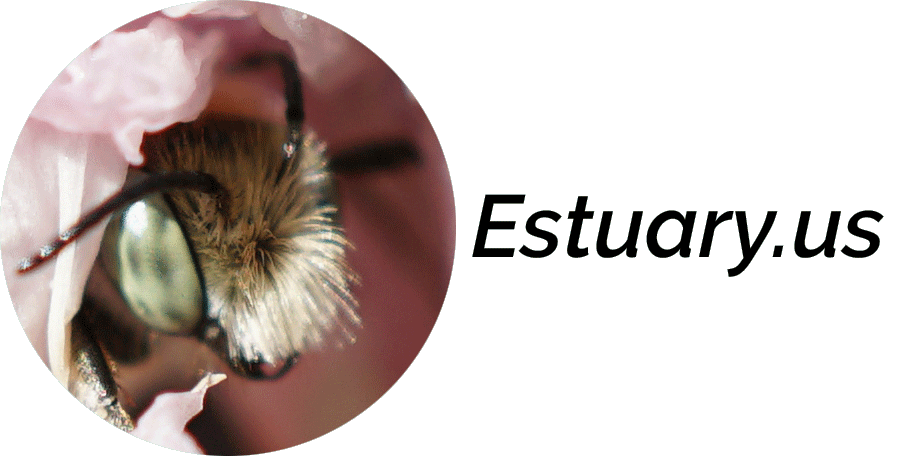Prologue
The first time I observed a Crotch’s Bumble Bee, Bombus crotchii (B. crotchii) was in June of 2019, during the first summer after the Woolsey Fire.
Prior to that sighting, nature had already demonstrated its remarkable power: Higher than average rain in the desert and surrounding areas had spiked a spring wildflower super-bloom. An abundance of blooms in the desert presented ideal conditions for what happened next: a migratory blizzard of Painted Lady, Vanessa cardui (V. cardui) butterflies flying north. On his website the butterfly expert Art Shapiro explains how and why: “Apparently the entire North American population winters near the US-Mexico border, breeding in the desert after the winter rains generate a crop of annual Malvaceous, Boraginaceous and Asteraceous hosts.”1 At its home base, V. cardui depends upon adequate floral resources to breed and begin its northern migration. In years with little rain, the species’ numbers are correspondingly low, because less food equals fewer butterflies. Weather difficulties may further complicate breeding and migration.2
The barren stretches of the burn-scarred Santa Monica Mountains in December of 2018 produced what seemed like endless fields of blossoms accompanied by continuous waves of butterflies. The experience was a once in a lifetime event for me. I realized that it was probable that I would never see anything like it again.
The devastation of the fire was followed by early signs of resilience: tap-rooted native plants put up new shoots; the quiescent seeds of wildflowers, both those of the fire-followers and others, awoke from their dormant state in the soil’s seed bank store. As spring folded into early summer, the new greens of Toyon and other shrubs emerged and began to re-established themselves, rising just beside the singed shoulders of their former selves. Witnessing nature’s response to the fire had a profound effect upon me. I think I was, for many years, receptive; or ready to receive but not fully aware, like a seed tucked comfortably in the soil, dreaming in my hard shell. I found myself back on a trail that I lost years ago.
The 2019 Sighting
I know the day was the 22nd of June, thanks to the date stamp on my photos. I had run up a trail in Malibu Creek State Park early that morning, and now, as had become my custom, I was walking back down the trail. The “training benefit” of running down hills was no longer worth the damage to my seasoned joints. The constraint of having to walk where I had previously run was to become a gift, because that is how I decided to reframe no longer have a choice. I could take the time to pause, be still and study the many forms of life around me.
Bumble bees, like many other bees and flying insects. produce a sound loud enough for the human ear to pick up. When I was a child, the sound of insects wings frightened me. I think I mistook that sound for a growl, for anger, for something malevolent. The sound originates from the insect’s flying muscles. That is all.
My initial impression was indeed auditory in nature: those very loud flying muscles caught my attention. “Wow! What is that?” I looked toward the sound and saw a species of bumble bee that I had never seen before. Can a bumble bee exhibit the attribute we humans call charisma? This one did.
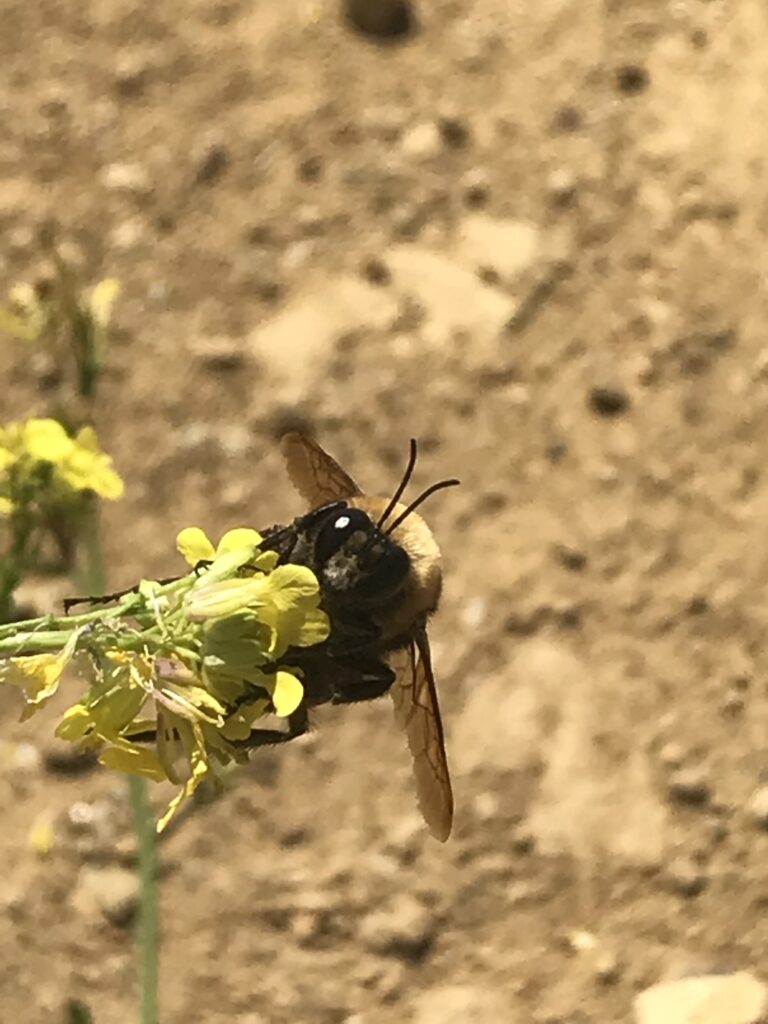
When I look back at my record of the observation, I can see that I did not know what sort of bee it was. I listed it in iNaturalist as an Apine bee (Apidae). The Apidae taxon is a pretty big umbrella: Apidae is a subfamily that contains many bee tribes, including the well known Western Honey Bee (Tribe Apini).
After the mystery bee flew away, I thought, “Well, that’s it.” I was wrong. Within 10-20 seconds the bee returned, perching itself on another Black Mustard plant nearby. It repeated this behavior several times. I know a little more about this bee now than I did then. This bee was a male who was surveilling his territory, chasing competitors and on the lookout for females. I suspect that of the two of us, I was the first one to leave the area. An entomologist and expert on native bees identified mystery bee: it was a Crotch’s Bumble Bee, Bombus crotchii. I am not sure why, but I did not see another B. crotchii until last summer.
I thought that the Woolsey Fire might have been a factor, as it scorched much of the Santa Monica Mountains. In the spring and summer of 2019, many of the plants that bees could rely upon for food were not flowering yet. But as I note above, quick fire-followers and species whose seeds respond well to fire and smoke as a catalyst were in bloom by spring.
I researched the possibility that fire might be a partial explanation for the gap between my 2019 sighting and 13 sightings in 2023, but was unable find any evidence to support that theory. Instead, I learned more about bumble bees and the floral resources they are able to forage. Bumble bees, in general, visit a wide range of flowers.3 B. crotchii is a nectar and pollen generalist. While some of the floral resources the bee would forage from would require years rather than months to bloom after the fire, others, the fast-growing species and the quick fire-followers, would be suitable resources for the female B. crotchii to feed herself and provision her eggs.
Approximately 70% of ground-nesting bees, including bumble bees, are set deep enough below the surface of the ground so as to be insulated from a catastrophic conflagration sweeping across the surface. Bees that nest above ground, in leaf litter or within hollow twigs and branches and tree holes, are unprotected and perish in a fire.4 As long as there are sufficient nearby populations of above-ground dwellers to repopulate a burned area, they will return when forage and habitat are available.
I like to think of the residential garden as a potential oasis for the wildlife around us. In that spirit, I encourage those who have the time and the space to put aside a patch of ground dedicated to ground-nesting bee habitat, and to cultivate some pollinator-friendly plants to provide food.5 I did exactly that around seven years ago. Now I see a variety of native bees in my yard. I have not found any native bee nests set in the ground yet, but I have spotted a couple Leafcutter bees (Genus Megachile) nesting in my backyard. On a couple occasions I was lucky enough to observe two separate female leafcutter bees flying to their solitary nests, each with a bit of leaf clasped in her mandibles. As the common name suggests, this bee lines the cells where she lays her eggs with pieces of leaves. Each of the two bees had chosen a nesting site located in protected crevices in my yard; where the cement between overhanging bricks had crumbled away.
I learned something about ground bee nesting depths when I asked a ranger whether the late fall grading maintenance on Albertson Fire road might have destroyed an aggregation of Bindweed Turret Bee nests. I watched the bees building and provisioning their turret-topped nests in early summer. Now the immature bees were overwintering in their nests, right in the middle of the fire road (a not uncommon location). The ranger assured me that the nests were located at least six inches below the level at which the plow blade graded. As with careful periodic grading, so with the nests of many, but not all, ground-dwelling bees: they have a good chance to remain unscathed by a fire on the surface.
B. crotchii’s active season runs from mid-spring to late summer. By the time Woolsey ignited, the next generation in the Santa Monica Mountains area was presumably already underground. A mid-summer fire on the other hand would have been devastating. If a fire comes through during a bee’s active season, floral resources near the nesting site may be destroyed; and smoke and haze may interfere with the bee’s ability to navigate between its nest and food.6
I think the answer to why I did not see B. crotchii again for four years is simply this: the first sighting was just a bit of luck. I spent plenty of time in the wilderness during the next four years. I observed and read about many life forms and relationships between them: arthropods including many native bees; the occasional mammal, reptile or bird; lots of green things, in their many forms. I sought out articles written by and for both generalists and specialists, and invested in reference books about bees and butterflies. I think that I needed to learn more about what I was trying to see, to gain a better understanding of how to see and think about the wild things around me, and finally, how and where to seek out what I wanted to find. True understanding is realizing that there will always be more to learn.
2023 Observations
Charmlee Wilderness Park, May 16
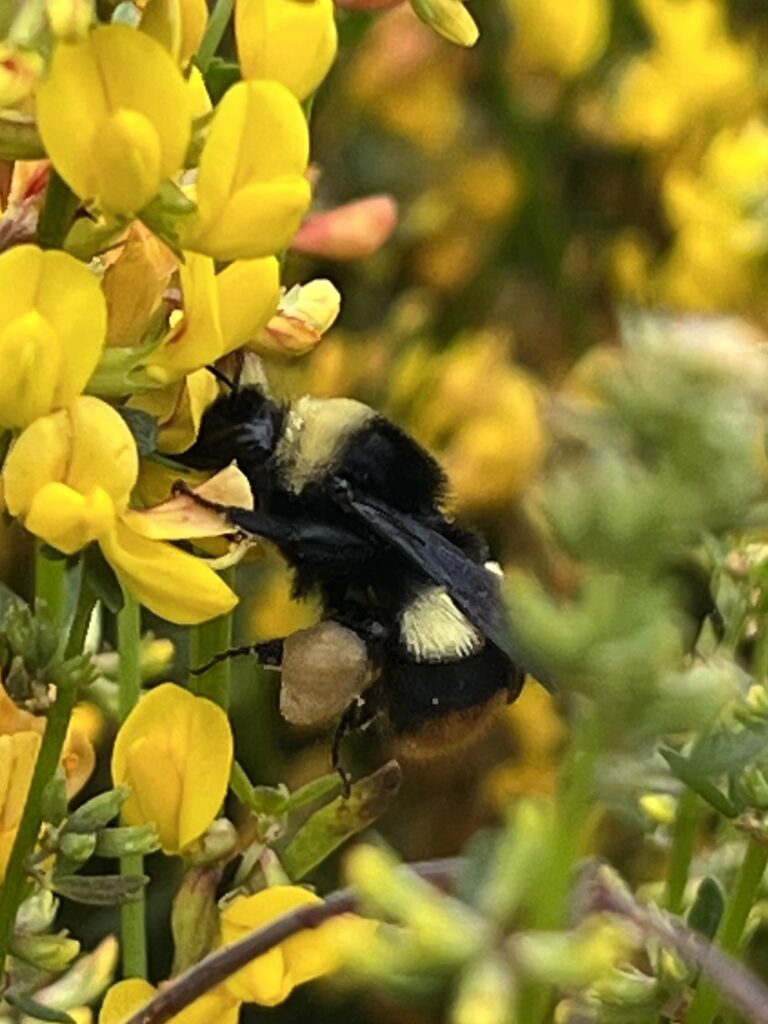
A female B. crotchii gathering nectar and pollen from Deerweed, Acmispon glaber. Notice the golden basket attached to the bee’s hind leg. This is a mixture of pollen and nectar, the food that she will bring back to her nest for the larvae to feed on after they hatch.

From the trail near where the bee was foraging, I looked toward the coast and saw a meadow of deerweed reaching toward the horizon. The shrub was in bloom all around me and in the surrounding hills.
Malibu Creek State Park, June 13
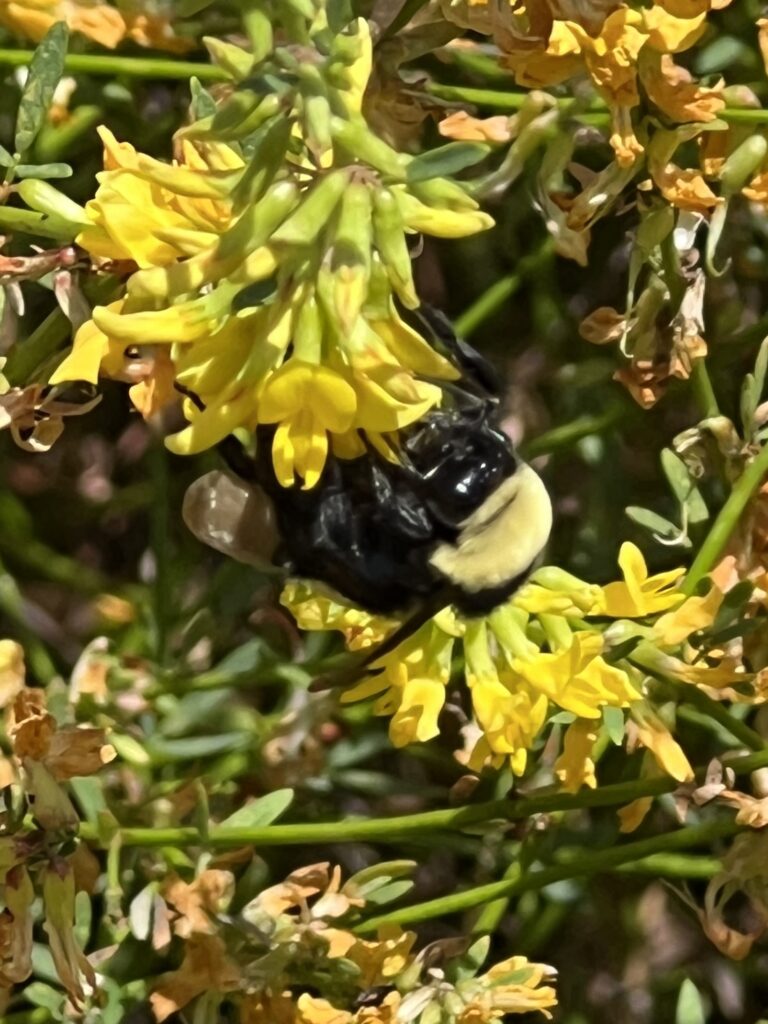
After a long out-and-back hike on Bulldog Motorway, I spotted a female B. crotchii on Deerweed foraging for food. She did not stay around for long. When she flew off I waited around for awhile, but after about ten minutes I continued walking.
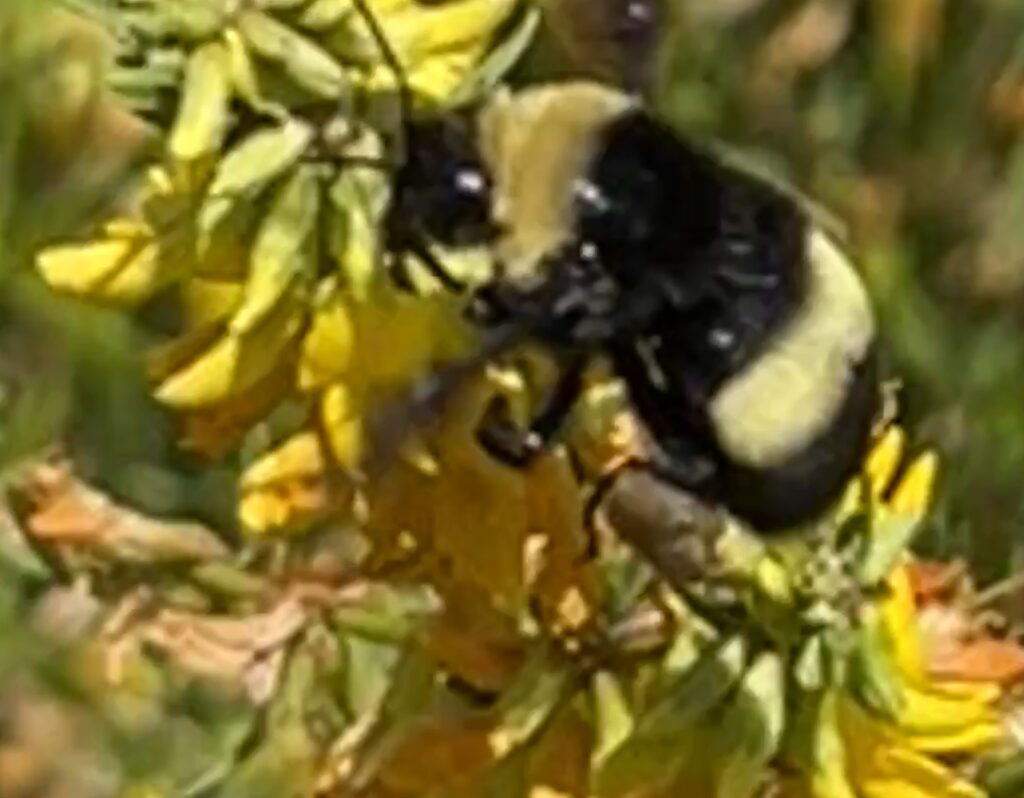
I have noticed that the female bees seem to be more wary of my efforts to get near enough to photograph them. When they leave, they usually do not return before I give up waiting.
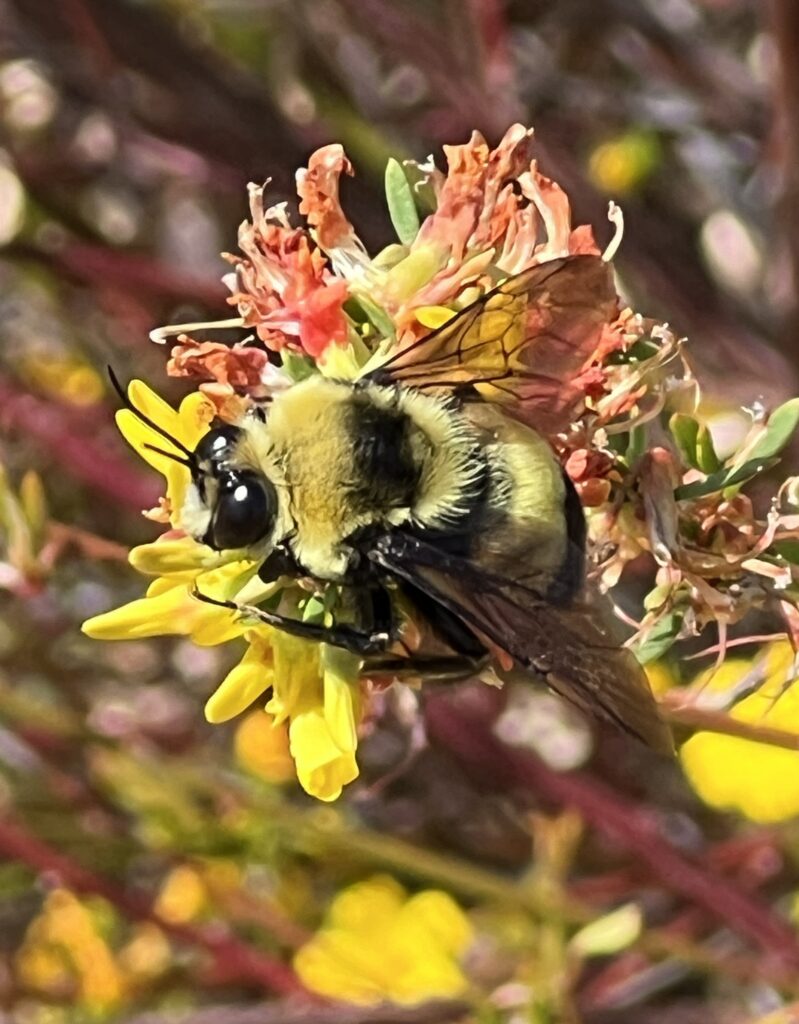
About 100 meters away from the female, a male B. crotchii was perched on stem of Deerweed. While perched he did not move much. The stem of deerweed that he was sitting on was waving around in the wind, that did not seem to have any effect on him. I did not see him foraging. He appeared to be waiting and observing.
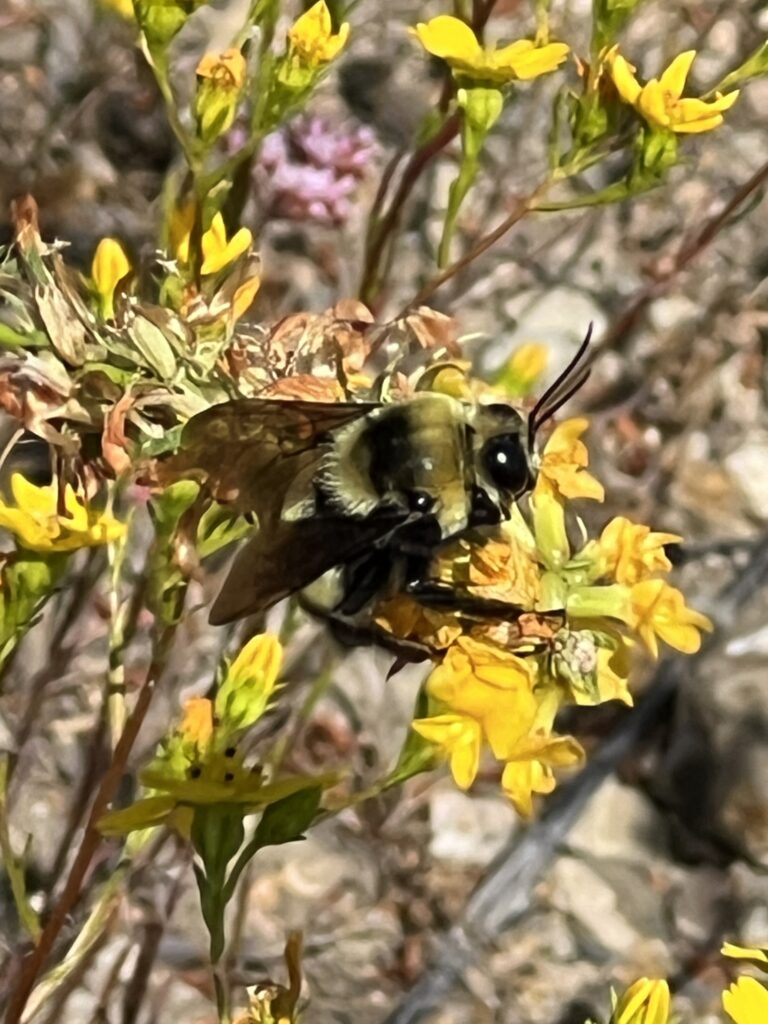
He was guarding his territory and perhaps, on the lookout for a female bee to pass by. This male, as with other males of the species I have observed, flew away and returned to the area several times. He flew away and then circled back, returning to the same or a nearby stem within a couple minutes.
Malibu Creek State Park, June 29

A male straddling buds of Chaparral Mallow. He appears to be looking straight at the camera, but his focus is elsewhere.
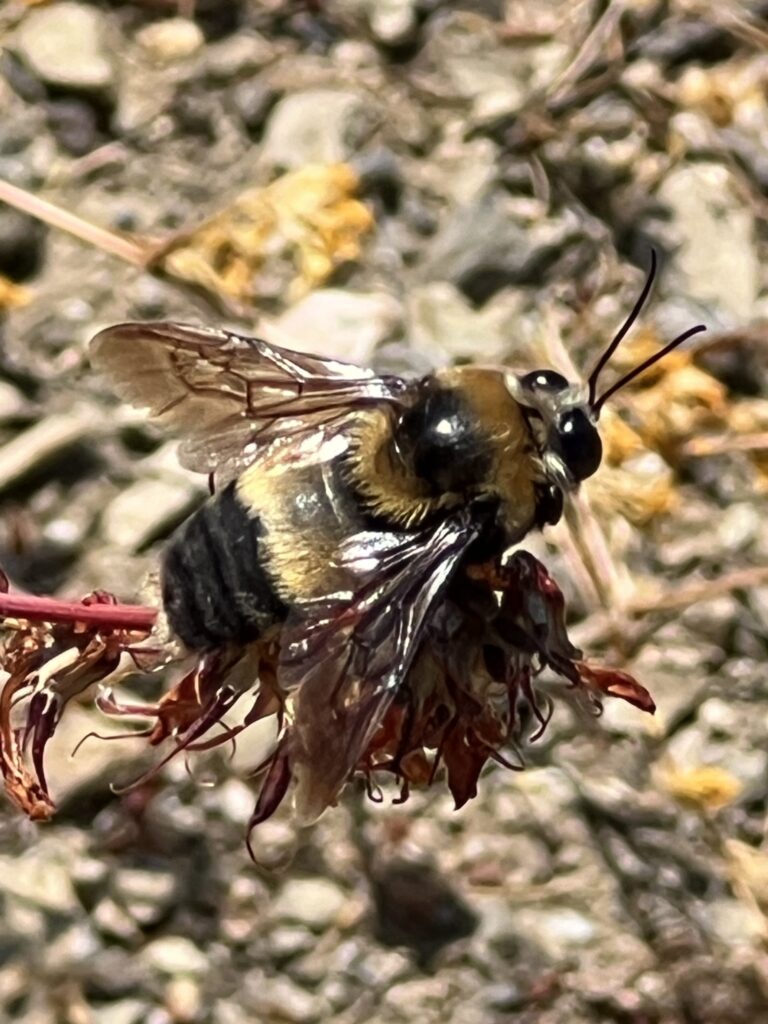
B. crotchii males spend much of their time in a perched, lookout position. If another bee or even a butterfly flies within its visual range, it takes off in pursuit of an intruder, competitor or potential mate.
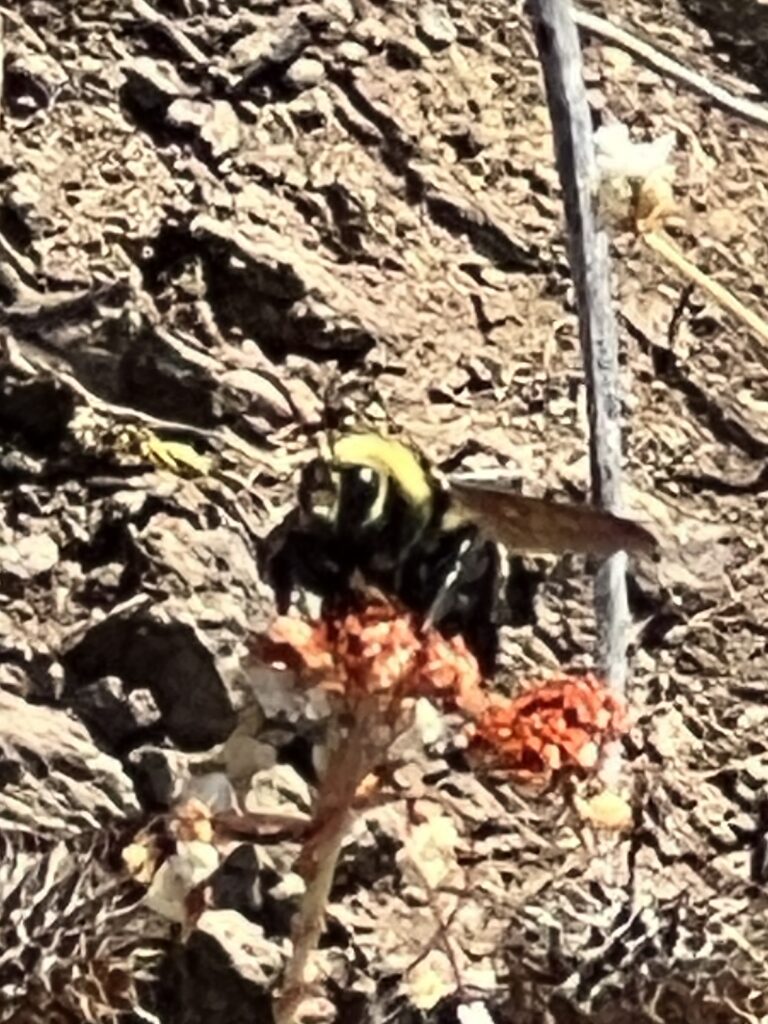
This male must have found a reason not to return to this reddening buckwheat. Maybe he was nearby, but well-camouflaged. I waited for ten minutes, hoping to get a better photograph, but it had been a long day of hiking.
Long Canyon Trail – Conejo Open Space, July 8
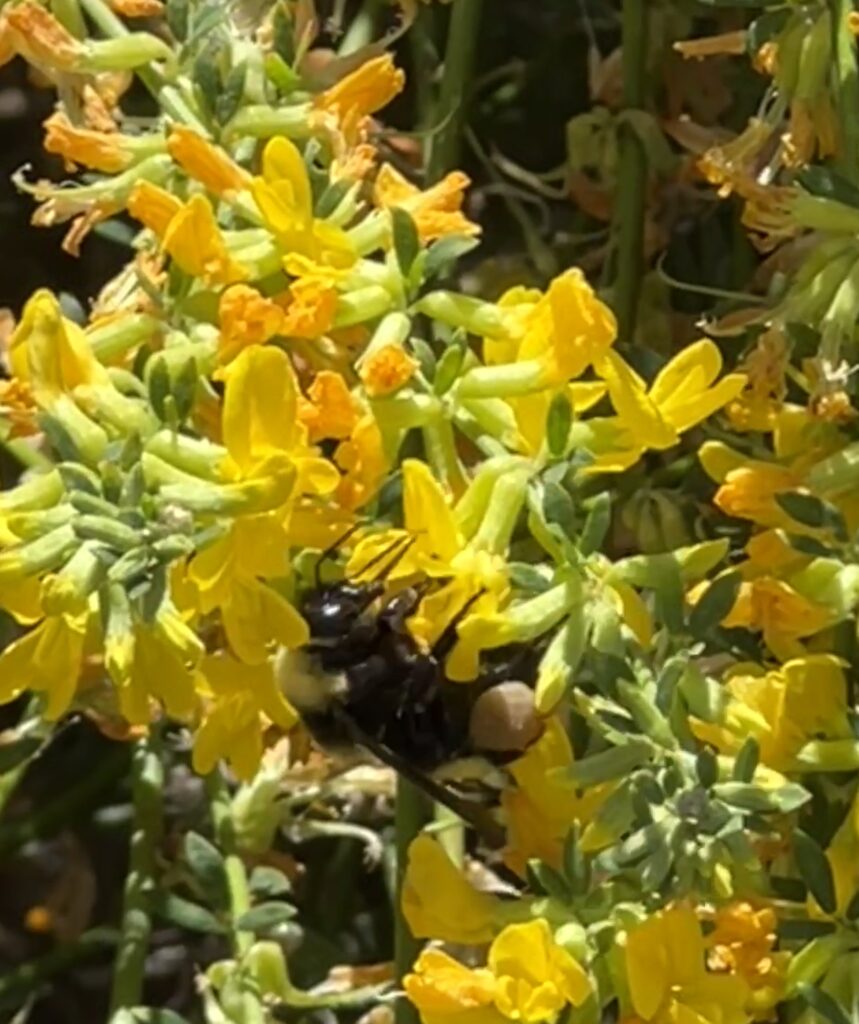
Back in Conejo Open Space, I noticed a female foraging on a perennial favorite of many pollinators: Deerweed. She was, by my count, the third female I observed on deerweed in 2023. The males seem to favor the shrub for perching, although dry grass or mustard will do.
Sunrise Trail – Conejo Open Space, July 8
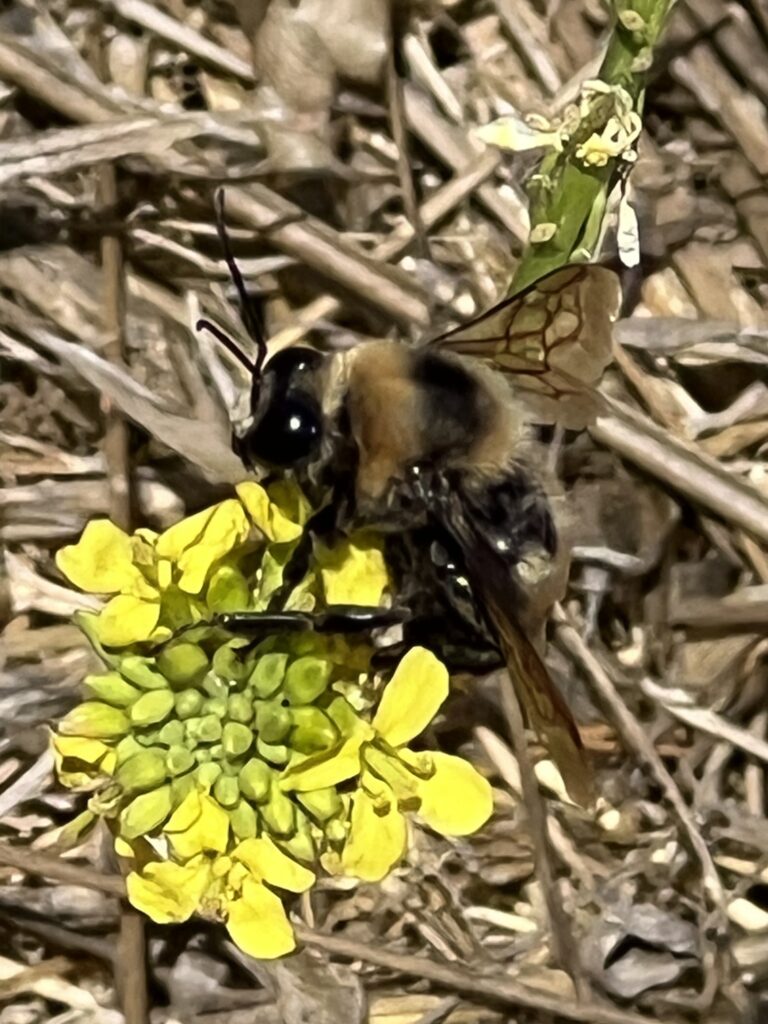
A male B. crotchii perched on a mustard plant. The surroundings have dried out in the summer heat. His colors are those of the soil and summer grasslands: burnt umber flows into gradations of gold and ivory against bits of both soft and shiny black.
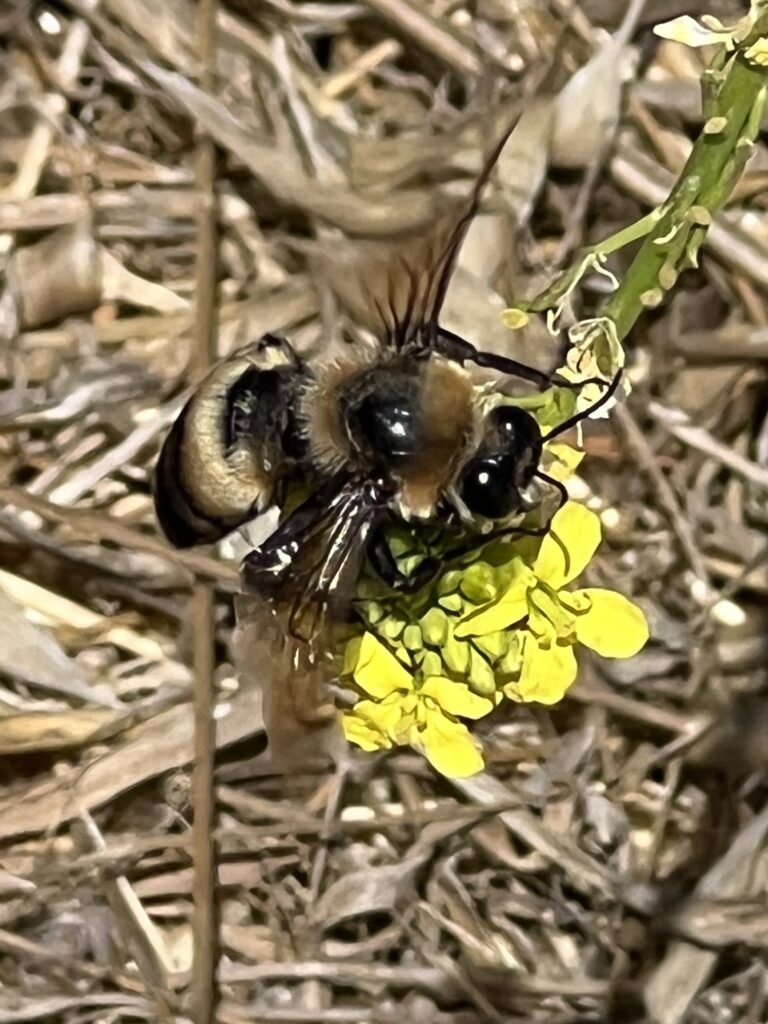
The same male on his previous perch, but now he sits facing the opposite direction after returning from a flight in pursuit of another bee.

Another B. crotchii male at a different spot along the Sunrise trail. The wind was blowing his grass perch around. This did not seem to pose any difficulty for him (e.g., see video below).
Cheeseboro Canyon Trail – National Park Service Land, Santa Monica Mountains, July 12
A female B. crotchii collecting nectar and pollen from stalks of Chaparral Snapdragon. This bee was foraging in a field of snapdragons growing in the open flat stretch between Sulphur Springs and Shepherd’s Flat.

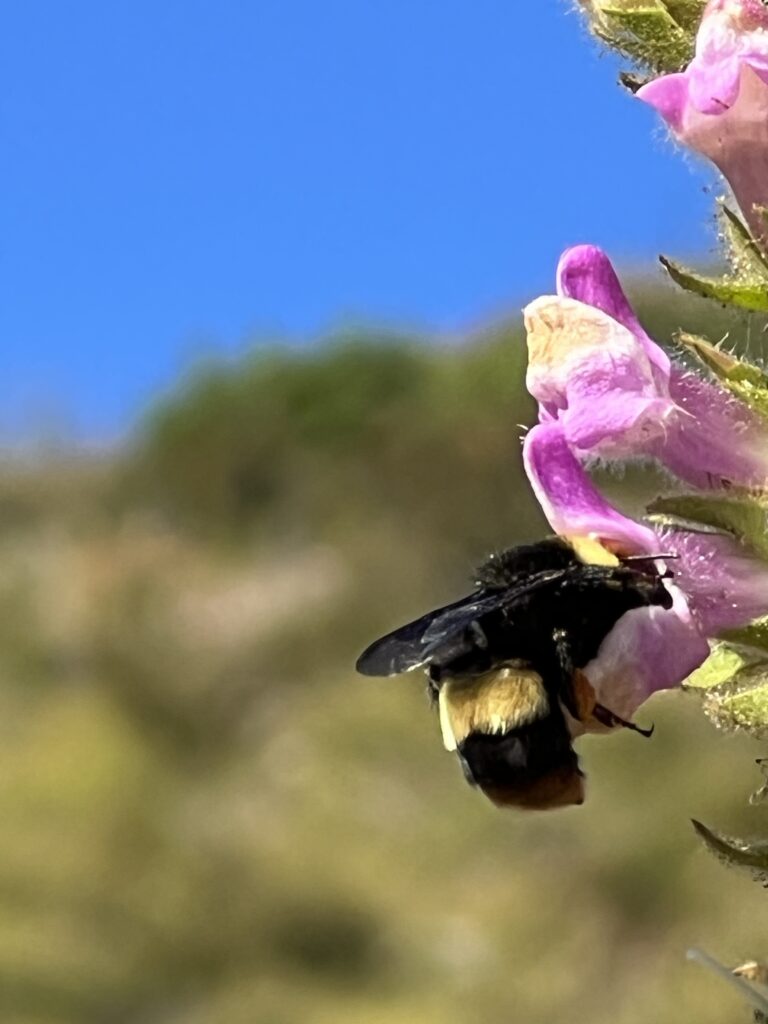


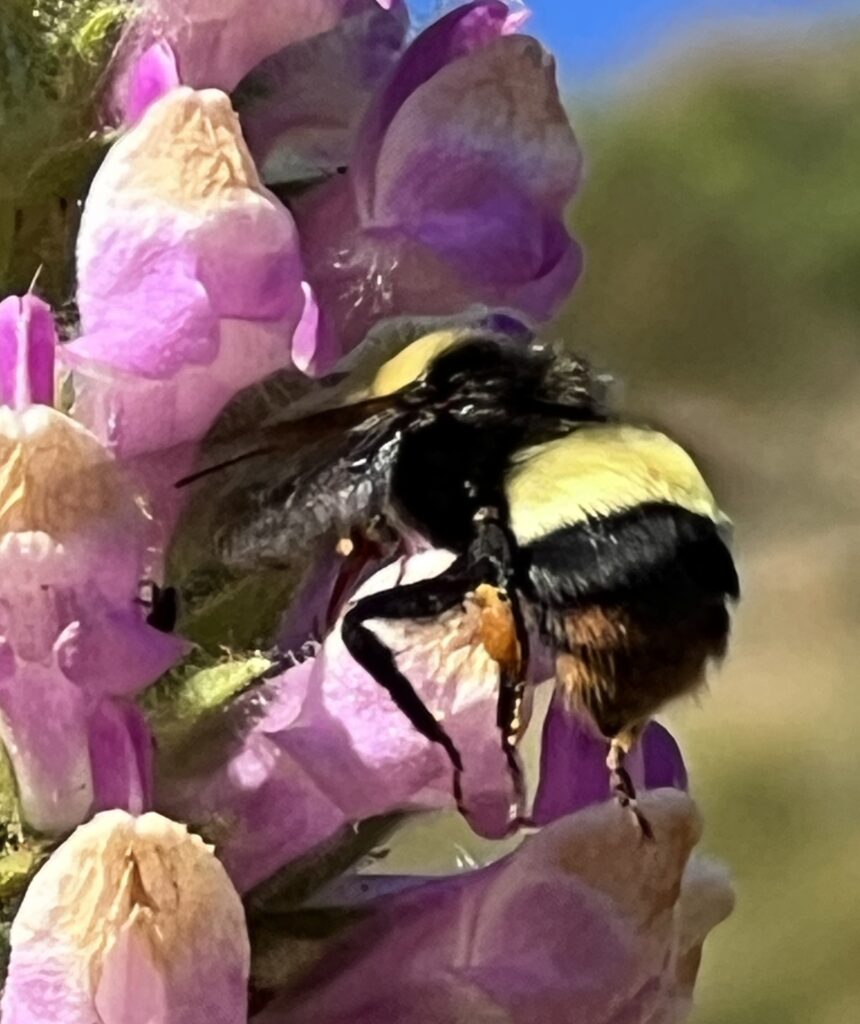
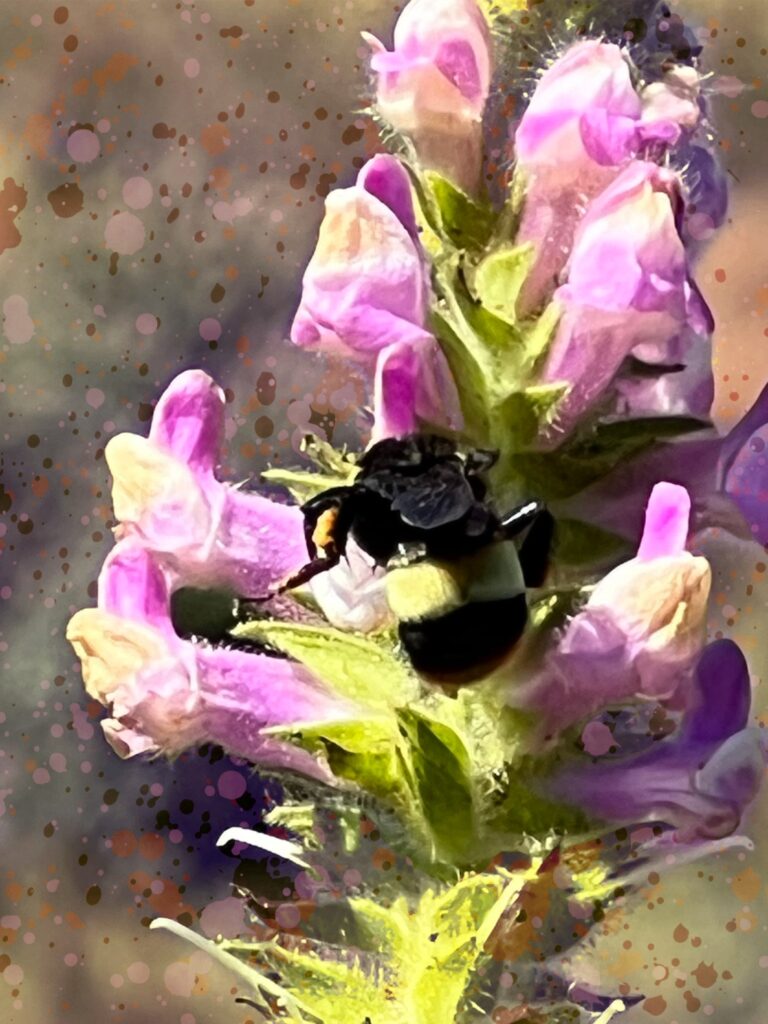
Sunrise Trail – Conejo Open Space, July 18
A male B. crotchii perched on a stalk of dried grass on a windy day.
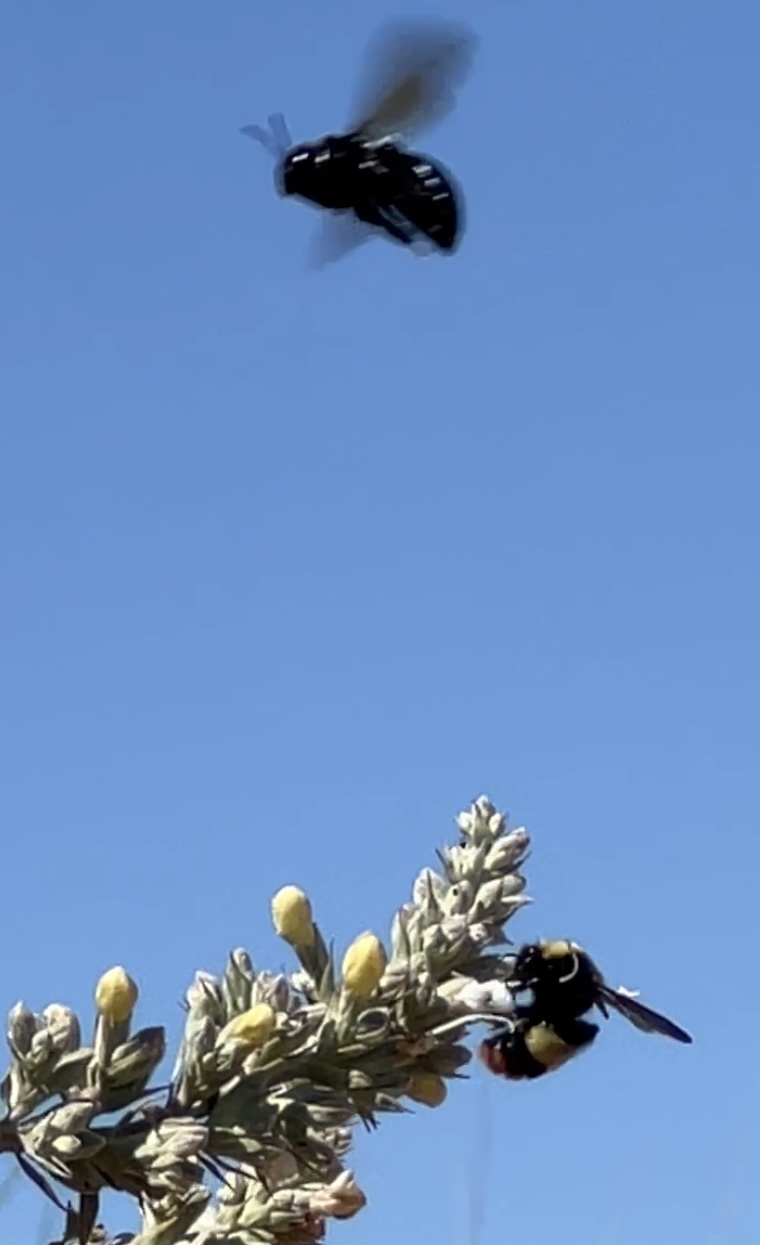
A female foraging on White Sage, Salvia apiana at the junction of the Sunrise and Oak Canyon trails in Conejo Open Space. The sage stalks reached high above my head; they were loaded with buds and blossoms. Another bee, possibly a carpenter bee, flew overhead and got caught in the photo frame. Just a short walk away, I encountered a male perching on a dry stalk of grass (video above).
Four Endangered Bumble Bees: Petition for Protection Under the California Endangered Species Act
On October 18, 2018, the Xerces Society partnered with Defenders of Wildlife and Center for Food Safety to submit a petition to the State of California Fish and Game Commission (the Commission) on behalf of four western bumble bee species whose populations are in decline.7 The petition was a request that the Commission take up and consider the petitioners’ request to list the four species as endangered under the California Endangered Species Act (CESA). The four bee candidates for listing were:
- Crotch’s bumble bee (Bombus crotchii)
- Franklin’s bumble bee (Bombus franklini)
- Suckley cuckoo bumble bee (Bombus suckleyi)
- Western bumble bee (Bombus occidentalis occidentalis)
In June of 2019, the Commission decided to accept the petition for consideration. Subsequent to that decision, the California Department of Fish and Wildlife began a one-year status review of the four threatened bee species.
Listing the bees under the CESA would prioritize the protections needed to preserve and possible reclaim habitat for the vulnerable species.
Populations of the four species have declined to such a degree that they are no longer present in much of their historic ranges in California and neighboring states. In the locations where they are still present, their numbers were diminishing.
The Franklin’s Bumble Bee faces the greatest threat of disappearing forever; it may already be gone. It has not been observed in California since 1998. In its range outside of California, it has not been observed since 2006. The Xerces, et al petition listed the Franklin’s bumble bee as in danger of imminent extinction.
Protection Under CESA Granted: A Long but Victorious Slog Through The Courts
In 2019, The Commission approved the petition and began the process of the listing the bees. In an attempt to stop the listing, agricultural and pesticide interests, led by the Almond Alliance of California and the California Association of Pest Control Advisors to name just the first two plaintiffs listed, promptly filed suit against the Commission and the California Department of Fish and Wildlife. The reason these businesses and their representatives did not want the bees protected was that a listing under the CESA would require the farming and pest control industries in California to follow new environmental rules. They were not interested in having to modify business practices to reduce potential harm to the endangered bumble bee species.
At trial the industry plaintiffs argued that since bees were terrestrial invertebrates (and not fish), they did not qualify for protection under CESA. The gist of this argument was that the language in CESA mentions fish and invertebrates, but not insects. One of the problems with the plaintiffs’ argument was that terrestrial invertebrates had already been listed under CESA, so a precedent of protecting non-aquatic invertebrates had already been set. In addition, insects are invertebrates. Nevertheless, the trail court ruled in favor of the industry plaintiffs.8
It took at least two years for the case to make its way to the California Supreme Court. After its initial filing in mid-2019, the case proceeded as follows:
- November 2020, trial court finds for the industry plaintiffs..
- February 2021 – Xerces and partners, including the Commission and the California Department of Fish and Wildlife appeal decision.
- May 2022 – The Third District Court of Appeals overturns the lower court ruling for the plaintiffs. The appeals court finds in favor of the State of California, Xerces and their partners, including, of course, the bumble bees of California.
- September 2022 – Industry plaintiffs submit a petition to the California Supreme Court (CSC), requesting a review of the Appeals Court’s decision. The CSC declined to review the case, which allowed the ruling by the Third District Court of Appeals to stand.
- December 2022 – the Department of Fish and Wildlife began conducting a status review of the four bumble bee candidates for CESA listing. As of April, 2024, this review appears to be either still underway, or the report has not yet been issued to the State of California Fish and Game Commission (the Commission).9 The Department of Fish and Wildlife serves in an advisory capacity to the Commission. The bees remain protected as endangered species while their candidacy for permanent listing is reviewed.10
Epilogue
The plants and shrubs where I observed the bees in 2023 had matured enough to flower and were blooming in abundance last year: Deerweed (from seed), White Sage (from burl or seed), Chaparral Snapdragon (from seed). The waves of winter rain helped our ecoregion, sometimes referred to as Mediterranean California, to recover some from the drought.11 This year, in 2024, I think we have had even more rain. A couple years of good rain seems to change everything. But we do live in an arid climate, a climate that will become less stable for many years into the future due to the greenhouse gases we have produced since the Industrial Revolution. I am not a gambler, but the return of drought conditions is an inevitability that I would bet on.
Some people I have spoken with, good, well-intentioned people and neighbors, have a dormant form of selective memory loss that seems to be activated by a wet (by southern California standards) winter: they want to return once again to plush lawns carpets, (a desert and a deathtrap for most beneficial insects), to gorgeous but thirsty exotics that evolved in the tropics, to get the state and the city off their backs, to relax all water restrictions because the reservoirs are now full.
When I hear this type of talk, which may or may not be accompanied by a sense of resentment and grievance about having to modify a wasteful behavior to maintain the integrity and stability of the paradise we live in, I wonder if our Promethean brilliance, along with an inability or refusal to think long-term, will be what dispossesses us of this paradise that we have the good fortune to live in and to steward, but never to own.
Citations
- Art Shapiro’s Butterfly Site. Vanessa cardui. Retrieved March 29, 2024, from https://butterfly.ucdavis.edu/butterfly/vanessa/cardui ↩︎
- Art Shapiro’s Butterfly Site. Vanessa cardui. Retrieved March 29, 2024, from https://butterfly.ucdavis.edu/butterfly/vanessa/cardui ↩︎
- Xerces Society for Invertebrate Conservation. About Bumble Bees. Foraging. Retrieved March 29, 2024 from https://xerces.org/bumblebees/about ↩︎
- OSU Extension Service. Oregon State University. How Do Wildfires Affect Bees? Retrieved April 15, 2024, from https://extension.oregonstate.edu/forests/fire/how-do-wildfires-affect-bees ↩︎
- Code, Amiee, Remember The Ground Nesting Bees When You Make Your Patch Of Land Pollinator-Friendly. June 20, 2019. Xerces Society for Invertebrate Conservation. Retrieved on April 16, 2024 from https://xerces.org/blog/ground-nesting-bees ↩︎
- OSU Extension Service. Oregon State University. How Do Wildfires Affect Bees? Retrieved April 15, 2024, from https://extension.oregonstate.edu/forests/fire/how-do-wildfires-affect-bees ↩︎
- Jepsen, Sarina, The Xerces Society Seeks Endangered Species Protections For California Bumble Bees. October 16, 2018. Retrieved on April 17, 2024 from https://www.xerces.org/blog/california-endangered-bumble-bees-2018 ↩︎
- Jepsen, Sarina, Court Decision Undermines The State Of California’s Ability To Protect Insects Under Its Endangered Species Act. November 20, 2020. Xerces Society for Invertebrate Conservation. Retrieved on April 2, 2024, from https://xerces.org/blog/court-decision-undermines-state-of-californias-ability-to-protect-insects-under-its-endangered ↩︎
- INSECTA, Order Hymenoptera (ants, bees, and wasps). California Natural Diversity Database (CNDDB). April 2, 2024. Special Animals List. California Department of Fish and Wildlife. Sacramento, CA. April 2, 2024. p. 33. Retrieved on April 16, 2024, from https://nrm.dfg.ca.gov/FileHandler.ashx?DocumentID=109406&inline ↩︎
- California Department of Fish and Wildlife. CDFW Seeks Public Comment Related to Crotch’s Bumble Bee, Franklin’s Bumble Bee, Suckley’s Cuckoo Bumble Bee and Western Bumble Bee. December 14, 2022. Retrieved on April 16, 2024, from
https://wildlife.ca.gov/News/Archive/cdfw-seeks-public-comment-related-to-crotchs-bumble-bee-franklins-bumble-bee-suckleys-cuckoo-bumble-bee-and-western-bumble-bee#gsc.tab=0 ↩︎ - United States Environmental Protection Agency (EPA). Ecoregions of North America. Level II Ecoregions. Level 11.0: Mediterranean California. Retrieved on April 16, 2024 from https://www.epa.gov/eco-research/ecoregions-north-america ↩︎
